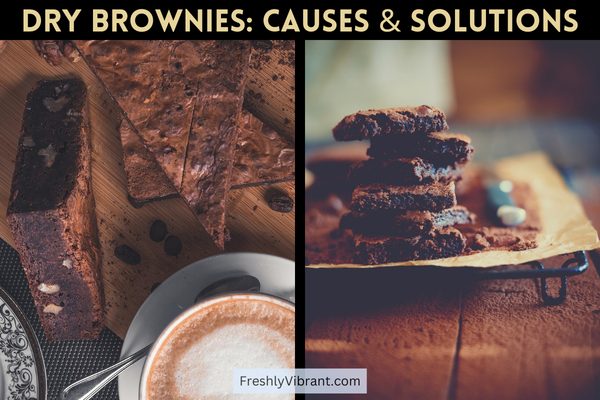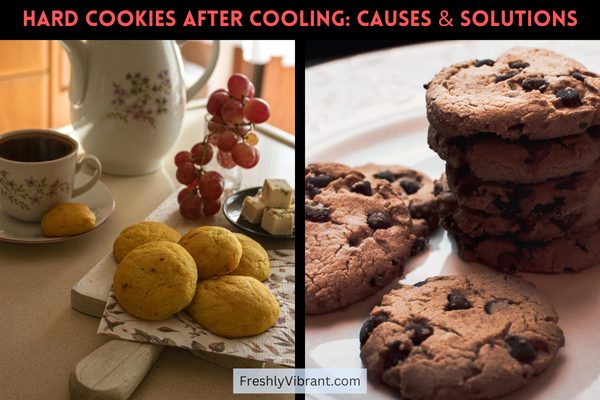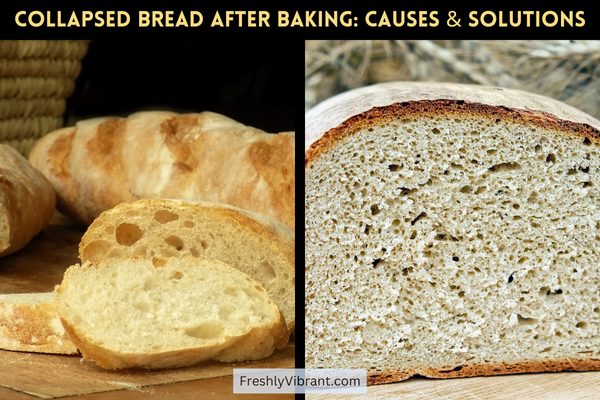Why Are My Cookies Flat? (And How to Fix Them!)
Ever pulled a tray of cookies out of the oven, only to find they’ve spread out like they’re trying to become one giant cookie pizza? Yeah… been there.
You wanted soft, pillowy bites of joy—and instead, you’re staring at sugary Frisbees. Don’t worry, you’re not a baking failure. Even pro bakers end up with cookie catastrophes from time to time.
In this guide, we’re breaking down the most common reasons your cookies might be falling flat (literally), and what you can do to bake picture-perfect treats every time.
Fun fact: Baking is basically chemistry… but with better snacks. Let’s get into the doughy details!

1. You Used Melted Butter (Oops)
Okay, I’ll admit it—I used to think melting the butter would make my cookies extra soft and chewy. Like, warm butter = gooey deliciousness, right? Yeah… no.
What I got instead were flat, crispy puddles that looked more like lace doilies than cookies. I didn’t realize I was sabotaging the structure before the dough even hit the oven.
Here’s the deal: melted butter causes your cookies to spread. That’s just baking science.
When the butter’s already liquid, your dough is way softer, and it doesn’t hold its shape as it bakes. So unless your recipe specifically calls for melted butter (some do!), it’s best to use it softened, not melted.
There’s a sweet spot. Butter should be room temp—soft enough to press with your finger but still solid.
If it’s shiny or sloshy, put it back in the fridge, stat. Using butter that’s too warm is one of the biggest reasons for flat cookies that spread way too much.
Solution
Now, if you accidentally melted it (been there), you can still save the batch. Just chill the dough for at least 30 minutes—an hour if you’ve got time.
Honestly, sometimes I throw mine in the freezer for a quick 15-minute fix when I’m impatient. The cold dough slows the spread when it hits the oven.
It’s like giving your cookies a pep talk to hold it together. Oh—and one more thing: use a cookie scoop. It makes your dough balls uniform, which helps even more with structure and bake time.
Combined with proper butter temperature, it’s a game-changer.
2. You Overmixed the Dough
Ah yes, the “just one more stir” lie we tell ourselves. I used to go full beast mode with my hand mixer, thinking the smoother the dough, the better. Big mistake.
Turns out, overmixing your cookie dough is one of the sneakiest ways to ruin a batch before it even starts baking.
When you mix past the point of “just combined,” you’re developing gluten—that stretchy protein in flour that gives bread its chew.
But cookies? They’re not bread. They’re supposed to be soft, tender, maybe a little gooey in the middle.
Too much gluten = tough, flat, or oddly cakey cookies. Not what we want.
So what does “just combined” actually mean? It means the dry ingredients are barely folded in.
You should still see a few streaks of flour when you stop. If you’re adding chocolate chips or nuts, do it with a spatula—not the mixer.
Solution
That way, you finish combining everything without overdoing it. Pro tip? After you mix in the eggs and vanilla, ditch the mixer entirely.
Use a wooden spoon or your hands. Yeah, your hands might get a little messy, but honestly, it’s better than winding up with cookie pucks.
One time, I whipped my dough until it looked like cake batter… and the cookies baked up so dense I could’ve used them as hockey pucks. Lesson learned.
Now, I treat my dough like it’s fragile—because it kinda is.
3. Your Oven Temperature Is a Liar
Let’s be real: most ovens are little liars. I didn’t find this out until I bought a cheap oven thermometer on a whim—and wow.
My oven said it was at 350°F, but the thermometer read almost 390°F. No wonder my cookies spread like gossip at a family reunion.
When your oven is too hot, the butter melts way too fast, and the dough doesn’t have time to set properly. That’s how you get cookies that flatten out before they even start rising.
And if it’s too cold? They’ll stay doughy in the center while the bottoms burn. Yep, been there too.
Solution
Here’s what I do now: I keep a little oven thermometer hanging from the middle rack. You can snag one for under $10.
It’s honestly one of the best baking tools I’ve ever bought—beats guessing. And always, always preheat your oven for at least 15 minutes before baking.
I know it’s tempting to throw the tray in early, but don’t. Also, rotate your pan halfway through if your oven has hot spots (most do).
Mine runs hotter on the left side—found that out the hard way when one half of a batch came out golden, and the other looked like scorched earth.
4. You’re Skipping the Chill Time
This right here was one of the biggest revelations for me. I used to be all about instant gratification—mix the dough, scoop the dough, bake the dough.
But skipping chill time? That’s a one-way ticket to flat cookie city.
Chilling the dough helps solidify the fat (usually butter), which means it takes longer to melt in the oven. That gives your cookies time to set and hold their shape.
It also deepens the flavor and improves texture—hello, chewier cookies with crisp edges. The first time I actually followed the chill time (an hour in the fridge), I was shook.
Same recipe, totally different result. The dough was firmer, easier to scoop, and the cookies? Chef’s kiss. They looked like something from a bakery window.
Solution
So how long should you chill? At least 30 minutes, but honestly, overnight is gold. And if you’re short on time, the freezer trick works too—15 to 20 minutes, tops.
Just don’t freeze too long or the dough will be rock hard. Trust me: your dough needs a nap, especially if it’s been through a lot (like melted butter or a warm kitchen).
5. You Didn’t Measure Ingredients Correctly
Listen, I know measuring sounds basic, but it’s where most cookie fails begin. I once eyeballed the flour because I was “experienced.” Spoiler: I was not.
The cookies came out greasy, thin, and sad. Baking is science, and the ratio of flour to fat is everything.
Too much butter, too little flour? Hello, spread city. Too much flour? Dry, cakey cookies.
If you’re still scooping flour straight from the bag with your measuring cup—stop. That packs it down, which adds more flour than you need.
Solution
Use the spoon and level method or better yet, weigh your ingredients with a kitchen scale. One cup of flour should be about 120 grams, give or take.
It sounds fussy, but it’s worth it. Your cookies will be more consistent every time.
Oh, and don’t forget brown sugar. Make sure it’s packed tight—you should be able to flip the measuring cup over and have it hold its shape.
That’s how you know you’ve done it right. Measuring right isn’t flashy, but it’s the secret sauce to cookies that actually turn out the way the recipe promised.
6. You’re Missing a Leavening Agent (Or It’s Old)
This one hit me hard during the holidays last year. I was so excited to bake a big batch of chocolate chip cookies for friends… and they came out looking like greasy crackers.
The culprit? My baking soda was dead. Like, flat-out useless.
Leavening agents like baking soda and baking powder are what help cookies rise and stay thick. Without them, or if they’re expired, your dough just spreads and bakes flat.
No lift, no fluff—just sad little cookie pancakes. Not every cookie recipe uses both, but they’re not interchangeable.
Baking soda needs acid to activate (like brown sugar or yogurt), while baking powder already has acid built in.
If you use the wrong one, or forget it completely (yep, done that too), your cookies won’t rise the way they’re supposed to.
Solution
Wanna test if your leavening is still alive? Drop a bit of baking soda in vinegar—it should fizz like crazy. For baking powder, use warm water.
No fizz? Toss it. That stuff loses power faster than you’d think, especially in humid kitchens.
Now I write the expiration date on every new box with a Sharpie. Sounds nerdy, but trust me—it saves you from wasting ingredients and your precious baking time.
7. The Baking Sheet Is Too Hot (Or Too Greased)
Oh man, this one got me so many times before I caught on. I used to reuse the same baking sheet batch after batch, thinking I was being efficient.
But every second batch of cookies? Totally flat. Turns out, putting cookie dough on a hot pan is a recipe for instant spread.
When your baking sheet is already hot, it starts melting the butter in your cookie dough before it even hits the oven. That early melt throws everything off.
The dough spreads out too fast and never has a chance to rise properly. Result? Thin, crispy, uneven cookies that bake too quickly on the bottom.
And don’t get me started on over-greasing. I used to spray my pans like I was oiling a bike chain.
But too much grease = zero friction = cookies sliding around and spreading even faster. Now, I swear by parchment paper or silicone baking mats.
Solution
They keep things non-stick without the extra oil—and they’re a breeze to clean. Pro tip: If you’re reusing a baking sheet, let it cool completely.
Run it under cold water if you’re in a hurry—just dry it well. Clean, cool pans give your dough the fighting chance it deserves.
Bonus Fixes for Cookie Perfection
Alright, so maybe your cookies still aren’t turning out bakery-perfect, even after all the usual fixes. Don’t worry—I’ve got a few extra tricks up my sleeve that have seriously helped me level up my cookie game.
First off, try mixing in some add-ins that naturally thicken your dough. Oats are amazing for this. I love tossing in a half cup of rolled oats for texture and structure.
Chopped nuts? Also a win. They not only add crunch, but they stop cookies from going full pancake mode.
Next, let’s talk about something most folks don’t even consider: altitude and humidity. I once baked a batch at my cousin’s house in Denver, and they came out totally different—drier, puffier, and way less spread.
If you live at a high altitude, you may need to tweak the flour and leavening. And if it’s super humid where you are, try cutting back slightly on liquid ingredients or baking a touch longer.
Another secret weapon? Letting your dough rest overnight in the fridge. I know it’s hard to wait, but it’s like magic.
The flavors deepen, and the texture is way better the next day. I’ve had people ask what I “added”—and all I did was let the dough chill overnight.
Oh, and last thing: cookie scoops. They’re not just for looks. Using one helps keep your cookies the same size, which means they all bake evenly.
Plus, it’s way faster than eyeballing every scoop. Honestly, with a few of these bonus moves, you’ll go from “eh” to “OMG, who made these?” in no time.
Conclusion
So, next time you find yourself face-to-face with a batch of cookie pancakes, don’t panic. With a few tweaks—chilling that dough, measuring like a pro, and showing your oven who’s boss—you’ll be back on track to cookie glory.
Remember: baking isn’t just about following rules—it’s about mastering the chaos (and sneaking some dough along the way).
So roll up those sleeves, preheat that oven, and show those cookies who’s in charge.






